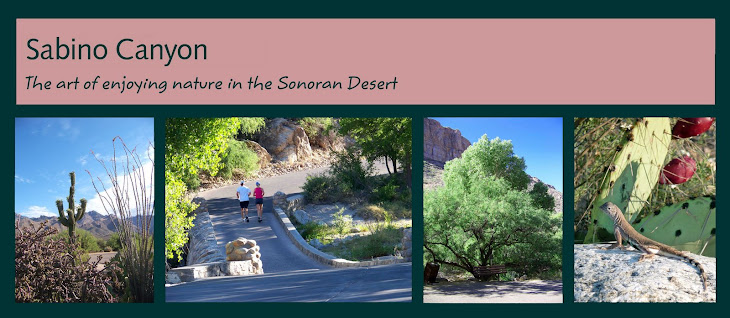
Desert Mistletoe (Phoradendron californicum) grows in deserts and foothills below 4000 feet in elevation. It is a partial parasite, using the host plant's water and some nutrients, but it can photosynthesize. The "kissing" type of mistletoe grows at higher elevations on deciduous trees, has bigger leaves and white berries. The leaves on the Desert Mistletoe are tiny and scalelike, and the berries are smaller and pinkish.
In the winter when the berries are ripe it is easy to see which trees have have mistletoe growing on them.
 Desert Mistletoe is found mostly on leguminous trees such as mesquite, palo verde, ironwood, and acacia, growing in clumps about 2' to 3' in diameter.
Desert Mistletoe is found mostly on leguminous trees such as mesquite, palo verde, ironwood, and acacia, growing in clumps about 2' to 3' in diameter.
 Phainopepla (Phainopepla nitens), pronounced fay-no-PEP-la is the most commonly observed bird eating mistletoe berries at Sabino Canyon. The name Phainopepla is Greek for "silky" or "shining robe." The males look like jet-black cardinals, but are actually in the silky-flycatchers family. Females are grey. According to Cornell Lab of Ornithology, one phainopepla can eat 1,100 mistletoe berries per day.
Phainopepla (Phainopepla nitens), pronounced fay-no-PEP-la is the most commonly observed bird eating mistletoe berries at Sabino Canyon. The name Phainopepla is Greek for "silky" or "shining robe." The males look like jet-black cardinals, but are actually in the silky-flycatchers family. Females are grey. According to Cornell Lab of Ornithology, one phainopepla can eat 1,100 mistletoe berries per day.Click on the picture below to see the phainopepla's red eye.


Besides Phainopeplas, other birds eat mistletoe berries including Northern Cardinals, Pyrrhuloxias, Verdins and Northern Mockingbirds such as the one pictured on the mesquite tree to the left.
In case you're wondering where the name mistletoe comes from: In ancient times it was observed that mistletoe grew on tree branches where bird droppings landed. It was called "mistletan." Mistel" is Anglo-Saxon for "dung," and "tan" is the word for "Twig." So, mistletoe means "dung-on-a-twig."





3 comments:
You're quite a photographer, and writer!
Were you once a teacher? I love your smooth way of educating us! :)
Wow, I had no idea there was so much life in a cactus. Having moved to LA from the East Coast (where you don't see too many native cacti), I'm lovin' all of the different plant varieties here, including cactus.............:)
Post a Comment